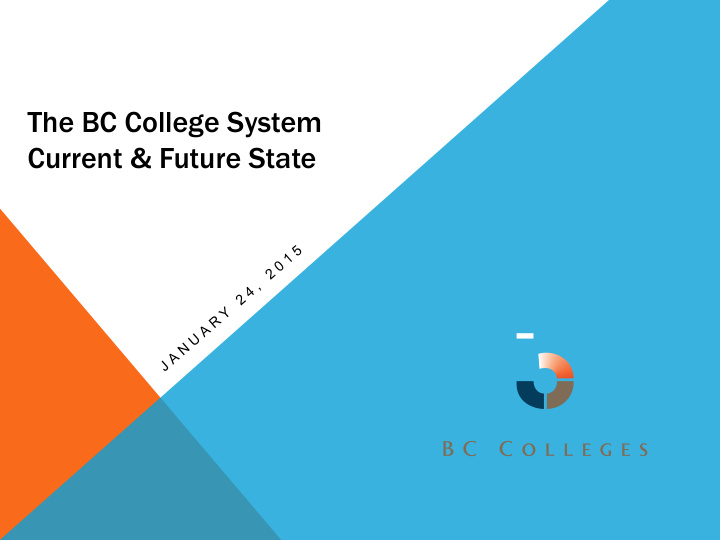



The BC College System Current & Future State
BC’S PUBLIC POST SECONDARY SYSTEM OVERVIEW British Columbia offers a wide range of public post-secondary options with more choices and more access, closer to home. • Over 1,900 programs are offered at BC's 25 publicly funded post- secondary institutions: • 11 universities – including six new universities in 2008. • 11 colleges – serving rural and metropolitan communities in BC. • Three institutes – offering a variety of specialized programs. Together they serve over 440,495 students in every region of British Columbia.
DISTINGUSHING FEATURES OF BC’S POST -SECONDARY SYSTEM • Comprehensive • Transferability within and across the system well established; • College to college • College to University • University to college • Over 1,000 block transfer agreements and 90 degree partnership agreements • Attention to working as one system on key public policy issues (recent phenomena) • Bilateral and multi-lateral collaborations and partnerships for example; • Dual Credit (K-12 to college) • Joint degrees (college & universities)
BC’S COLLEGE SYSTEM • 11 colleges with +60 campuses and learning centres in every region of the province. • +250 different academic, trades, career, technical and skills programs serving +160K students annually.
STRENGTHS OF BC’S COLLEGE SYSTEM • + 90% of BC college graduates transition into the workplace within 6 months. • Diverse programming – adult academic education, foundation, career, technical, trades, university-transfer and baccalaureate programs with an applied focus. • Prepare a highly skilled workforce – 44% of jobs will require a college education by 2022. • Build strong and vibrant communities – in over 60 locations and every region of the province our colleges educate people where they live. • Collaboration and partnership within college system “United college system working as one to address BC’s labour market requirements”. • Provide a strong ROI – for every $1.00 spent returns $3.10 in lifetime earnings & 15.40 return in added income and earnings to society.
CHALLENGES OF BC’S COLLEGE SYSTEM • 3 years of targeted cuts to PSE (no increase to Base since 2008) • Non-funded inflation on operating and instructional services. • Funding cuts to ESL and ABE. • Aging facilities – obsolescence. • Outdated equipment. • Lack of broadband capacity in remote areas. • Increased demand by government to provide training for LNG and other major projects (eg. Site C) with no increased funding to the Base. • Shrinking portion of operating grant available to PSE.
SITUATION ANALYSIS • Question of financial sustainability – structural deficits. • Lack of operating, program and facility capacity. • Little or no flexibility to respond to shifts in regional demand. • Succession and renewal of human capital needs to be addressed. • Centralization and control in Ministry of Finance: Impacts BC College boards control or authority to direct institutions Targeted funding – limited institutional discretion • Core review of institutional mandates and program direction. • Labour market data indicates significant skills and experience gaps starting in 2016. • Government aligning funding with LMI and workforce requirements.
LABOUR MARKET IMPLICATIONS FOR BC’S POST SECONDARY SYSTEM
BC’S COLLEGES EDUCATE STUDENTS FOR 53 OF BC’S TOP 70 IN DEMAND JOBS THAT’S OVER 76% Registered nurses Construction managers Administrative assistants Electricians Administrative officers Restaurant & food service managers Carpenters Welders Financial auditors & accountants Steamfitters Bookkeepers Millwrights Social & community service workers Senior Managers: construction, transportation, production & utilities Licensed practical nurses Early childhood educators
BC SKILLS FOR JOB BLUEPRINT (APRIL 2014) • New policy direction aligning education and training system to government economic growth strategy. • Alignment of education (K12) and PSE to skills plan of government. • Three areas of focus: K12, PSE & Industry. • PSE – 25% of operating/programming aligned with 70 high demand occupations by 2017 (25% operating base now targeted). • Labour Market Priorities Board – all key investment decisions must demonstrate alignment to Blueprint (outcome based funding).
BC COLLEGES’ PLAN TO MEET BLUEPRINT OBJECTIVES 1. Provide A Head-Start To Hands-On Learning Through Collaboration & Partnership With K-12 • Develop and pilot a BC Transitions Framework & Strategy (eg. Dual Credit) 2. Build Stronger Partnerships With Industry & Labour To Benefit Communities Across BC • Launch a Learning Partnership Fund 3. Shift Education & Training To Better Match Jobs In Demand • Transform adult academic upgrading and launch a BC Adult Employability Pilot
THE WAY FORWARD • Board Chairs communicating and working together. • Council of Presidents committed to working as one college system. • Collaboration and partnership between institutions, industry and labour. • New approaches to delivering education through multiple channels or partners (e.g. Consortia for trades or contact training). • Shared services, increasing efficiency & effectiveness. • Focus on own solutions – shape own destiny – don’t expect government to be part of the solution. • Explore new partners and other sources of revenue.
Thank you.
Recommend
More recommend